CANON EOS 650 User Manual
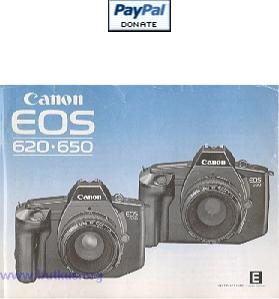
Canon EOS 620-650
Camera Manual
POSTED 12-5-02
This is the full text and images from the manual. This may take 3 full minutes for all images to appear. If they do not all appear. Try clicking the browser "refresh" or "reload button".
This camera manual library is for reference and historical purposes, all rights reserved.
This page is copyright© by  , M. Butkus, N.J.
, M. Butkus, N.J.
This page may not be sold or distributed without the expressed permission of the producer I have no connection with any camera company
If you find this manual useful, how about a donation of $4 to: M. Butkus, 29 Lake Ave., High Bridge, NJ 08829-1701 and send your E-mail address too so I can thank you.
Most other places would charge you $10.50 for a electronic copy or $20.00 for a hard to read Xerox copy.
This will allow me to continue to buy new manuals and maintain these pages. It'll make you feel better, won't it?
If you use Pay Pal, use the link below. Use the above address for a check, M.O. or cash.
To main Chinon/Ricoh manual site
Introduction
Thank you for purchasing the Canon EOS 620/650. Designed with the most advanced and innovative technology available, this high performance AF/AE SLR camera with a built-in motor drive offers you genuine, creative freedom and picture-taking ease.
Enjoy Taking Photos More Comfortably
This is EOS' design theme. The EOS 620/650 has brilliantly made it come true thanks to the high speed, precise auto-focus system and the built-in motor drive capable of winding film up to three frames per second which maximizes your potential.
Needless to say film speed setting and film transportation have been completely automated. A few of the many features of the EOS 620/650 are the evaluative metering function (Factor 6 light analysis system) in which the camera automatically recognizes subject pattern and its size so correct exposure can be obtained in backlit situations, and the intelligent program AE mode which selects the ideal program line according to the characteristics of the lens in use.
In addition, your photographic options are further expanded by exclusive accessories such as the Speedlites 420EZ and 300EZ that respond to a wide range of illuminations from dark surroundings to fill-in flash, the

Quartz Date Back E that imprints data, and the Technical Back E that memorizes exposure control data. For a full understanding of the EOS 620/650, please read this instruction booklet carefully before using the camera.
While reading these instructions unfold the front and back flaps of this booklet for easy reference to the camera s parts.
EOS" is derived from "Electro-Optical System" originating from the completely electronic data communication between the camera and lens. Further, "EOS,' is the Goddess of Dawn in Greek mythology--heralding the new, genuine AF system generation.
``EF" lens stands for ..Electro-Focus" and adopts the lens-integral auto focus system which uses special motors to make precise and high-speed auto focusing possible whatever the lens focal length.
Table of Contents
Preliminary Preparations
1.Attaching the Lens 6
2.Loading the Battery 8
3.Checking the Battery 9
4.Loading the Film 10
[Automatic Film Speed Setting] 12
Basic Steps
1.Setting the Main Switch to the "Full Auto" Position 14
2.Holding the Camera 15
3.AF Focusing 16
4.Exposure 17
[Display Panel Illumination] 18
5. Automatic Film Rewind 19
[Rewinding Mid-Roll] 20
Making the Most of Your EOS 620/650
1.Main Switch Functions 22
2.Setting the AF Mode 24
3.Setting the Film Winding Mode 26
4.Setting the Shooting Mode 27
(1)Program AE 28
(2)Program Shift Function 30
(3)Shutter-Priority AE 32
(4)Aperture-Priority AE 34 [Depth of Field] 36
(5)Depth of Field AE 38
(6)Manual 42
5 Partial Metering 44
6.Exposure Compensation 46
7.Auto Exposure Bracketing 48
8.Multiple Exposures 52
9.Difficult Subjects for Auto-focus 54
10.Manual Focusing 56
Other Shooting
1.Self-timer Photography 58
2.Dedicated Flash Photography 60
3.Bulb [Long Exposure] 63
4.Shooting with Infrared Film 64
Accessories 65
Caring for Your Camera 72
Other Notes 73
Appendix 74
Specifications 82
Carrying the Camera 87
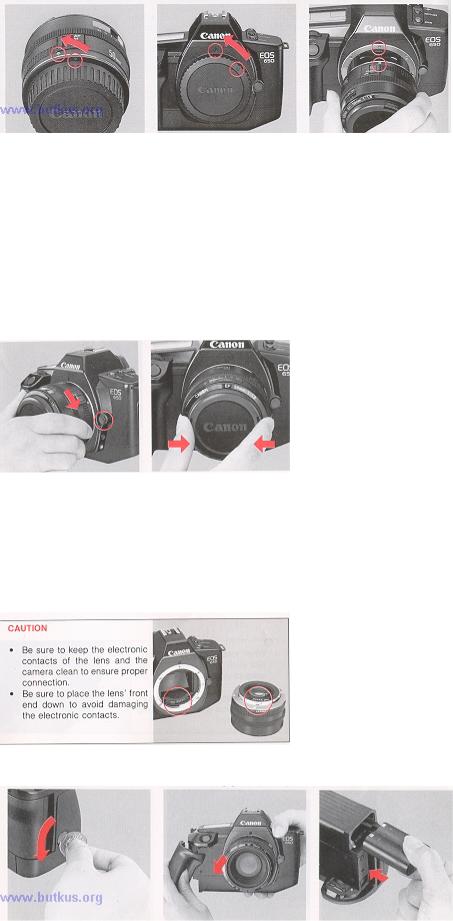
1. Attaching the Lens
1) Turn the rear lens cap in the direction of the arrow until it stops and remove it from the lens.
· To attach the rear lens cap, align its ''O'' mark with the red dot on the lens. Then lightly push it in and turn it clockwise until it stops.
2) Turn the body cap counterclockwise and remove it.
· To attach the body cap, align its "o" mark with the camera's red dot, then turn the cap clockwise. 3) To mount the lens, align the lens mount positioning point with the camera's red dot.
4) Then turn the lens clockwise until it stops and the lens is locked with a click.
· To remove the lens, turn it counterclockwise while pressing the lens release button. 5) Remove the front lens cap.
CAUTION
2. Loading the battery

1)Remove the grip with a coin or similar object.
2)As shown in the photo, load the battery so that its terminals face in the direction of the camera. Make sure the battery is pushed in all the way until it is locked by the orange lever
3)Replace the grip securely.
·When replacing the battery, first push the orange lever upward to remove the dead battery.
·When using a tripod, dismount t the camera before replacing the battery.
3. Checking the Battery
1 ) Set the main switch to the green "Go", "A" or "(-)"mark. The display will come on at this time. If the display does not appear, confirm that the battery is loaded correctly.

2) Open the switch cover on the back of the camera and press the battery check button( ). Battery power shows in the display panel.
). Battery power shows in the display panel.
4. Loading the Film
1)To open the back cover, push the back cover latch down while pressing the back cover lock button
2)Insert the upper-flat end of the film cartridge into the film chamber first. The film-load check mark (OIL) appears in the display panel.
3)Pull the film leader across the shutter curtain until its tip is aligned with the orange index.
CAUTION
*Before loading the first roll of film, remove the plastic insert.
*NEVER touch the shutter curtain. Its high-precision design makes it sensitive to pressure. Also, when loading the film be careful that the film leader does not touch the shutter curtain.

4)Make sure that the film has no slack and that its perforations are properly engaged with the sprocket teeth.
5)Close the back cover. The camera advances the film automatically and stops when "1" appears in the frame counter in the display panel.
6)During film advance, the film transport bars will appear at the bottom of the display panel moving in sequence from left to right. However, if the film does not advance correctly, the bars blink after the camera has stopped and the shutter will. not release. Reload the film.
If the film leader extends past the orange index, take out the film cartridge and manually rewind the excess film back into the cartridge.
Film becomes soft and tears easily in high humidity. Keep it stored in its canister until loading.
Automatic Film Speed Setting
The camera automatically sets film speed by sensing the DX code marked on the film cartridge. (ISO 25 - 5000 according to DX code standard)
1. The automatically-set film speed will appear in the display panel while the film advances to the first usable frame.
2.. When using film without a DX code, set the speed manually by following these steps: (ISO6-6400).
1 ) Set the main switch to either "A" or " ((*)) ".
2)Open the switch cover, and press both the blue and yellow buttons at the same time to display the ISO film speed number.
3)Turn the electronic input dial until your film speed displays.
·Once the buttons are depressed, you can remove your fingers because the ISO display is held on for approximately eight seconds. To clear this status within eight seconds, press the shooting mode selector.
·The previously set film speed appears and blinks in the display panel to warn you if the film speed has not been set. Always be sure to set the correct film speed, because the warning stops after film speed setting.
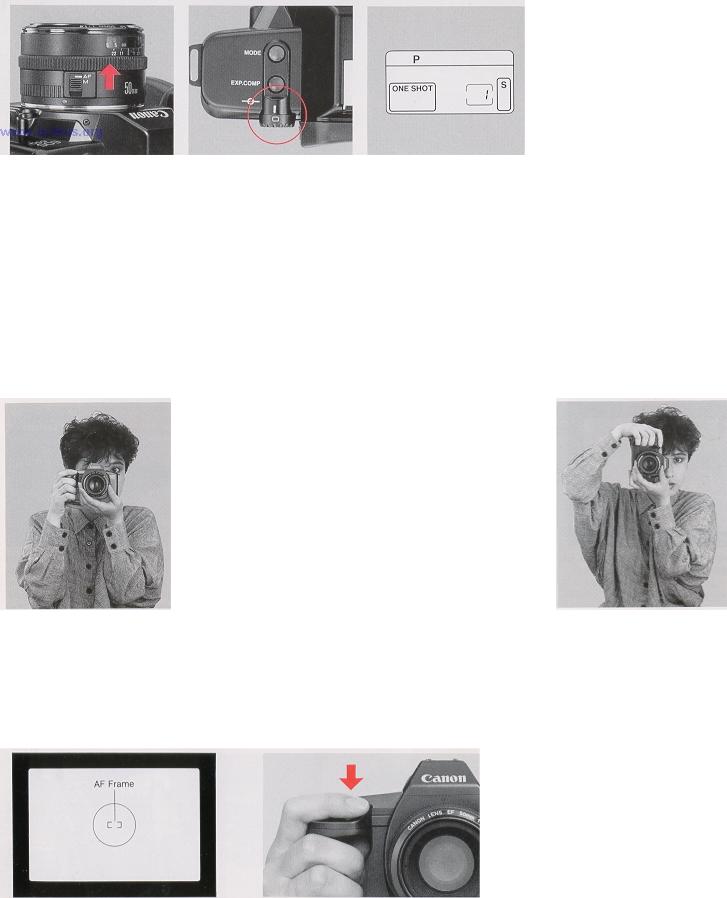
Basic Steps
1. Setting the Main Switch to the "Full Auto" Position
1)Slide the lens focus switch to "AF"
2)Set the camera's main switch to the "Full Auto" position (the green " 0 " mark).
The following displays will appear:
ONE SHOT: One of the AF modes.
P (Program): One of the AE modes.
S (Single): One of the film winding modes.
For further details on the above displays, please refer to pp. 24, 26 and 27.
2. Holding the Camera
Your pictures will not be sharp if the camera moves as the shutter is pressed. This movement is called "camera-shake." To avoid this, try the following camera-holding technique:
1) Hold the camera firmly, with your left hand supporting the camera and lens.
2)Press your left elbow close to your body.
3)Lightly hold the camera against your cheek or forehead and look into the viewfinder.
4)Spread your feet slightly apart, one foot ahead of the other, and relax.
There is no one correct way to hold the camera, so experiment to find the most comfortable way. If possible, lean against a steady support such as a tree, wall, or table to help you keen the camera still.
3. AF Focusing

1) Center the AF from ('[ ]" mark) over the main subject.
Do not touch the lens' moving parts during AF focusing.
2) Press the shutter button halfway and automatic focus (AF) starts. When correct focus is obtained, the green AF in-focus indicator lights up in the viewfinder and the AF focus signal (short electronic beeper tone) sounds.
·Original focus remains locked, even if the subject or focusing distance changes as long as the shutter button is held halfway.
·When AF is impossible, the green AF in-focus indicator will start blinking and the shutter will not release. (see pp. 54 to 56.)
4. Exposure
1) Gently press the shutter button halfway to check the exposure. Exposure will be correct if the shutter speed and aperture values remain continuously lit at the bottom of the viewfinder.
·Once the shutter button is pressed halfway, the display is held on for approximately eight seconds.
·When the automatically-set shutter speed is too slow to hand-hold, the camera-shake warning sounds (long electronic beeper tone). We recommend using a tripod or a flash.
·If correct exposure is not possible, both the shutter speed and the aperture blink to warn you. Underexposure warning--Switch to flash photography.
·In underexposure warning, the maximum aperture of the lens in use blinks. (The blinking shutter speed is always 30".)
Overexposure warning--Use an ND (neutral density) filter.
·In overexposure warning, the minimum aperture of the lens in use blinks. (The blinking shutter speed is always 2000 with the EOS 650 and 4000 with the EOS 620.)
2) Compose the picture and while continuing to hold down the shutter button gently press the shutter button completely to take the picture.
·The camera automatically advances the film to the next frame.
·Set the main switch to "L" to turn off the
Display Panel Illumination (EOS 620
Only)
Press the display panel illumination button to illuminate the display panel for approximately eight seconds.
· To turn off the illumination within eight seconds press the display panel illumination button again.
This camera is equipped with advanced "evaluative metering" so it automatically recognizes lighting conditions, subject pat" tern, and even subject size in the picture area. Even when there is a difference in brightness between the main subject and the background (e.g. backlit photography), correct exposure can be obtained without exposure compensation.
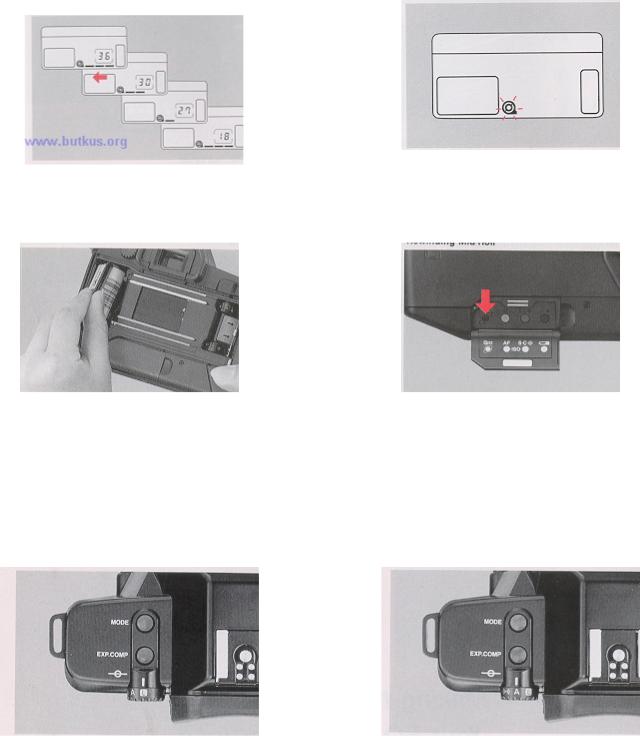
5. Automatic Film Rewind
The film automatically rewinds at the end of the roll.
1) During rewind the film transport bars move in sequence from right to left to indicate the function in progress while the frame counter counts in descending order.
3) Remove the film cartridge.
2) Film rewind stops automatically when the film has been completely rewound. Open the back cover when the film-load check mark(~) blinks.
Press the film rewind button (~) to rewind before the roll ends. The function begins immediately.
Making the Most of Your EOS 620/650
Detailed explanation of other modes to make picture-taking fun.
1. Main Switch Functions
The main switch has four positions.
L (OFF): Turns off the camera. Be sure to set at this position to prevent accidental shutter release when not in use.
A (ON): Activates the camera. (The electronic beeper tone does not sound at this position.)

((*)) (ON): In addition to being the same ON position |
[ ] (ON): Full auto position. The setting will be as |
as "A", the electronic beeper tone sounds in the |
follows automatically regardless of the mode. 1) AF |
following cases; |
mode - ONE SHOT 2) AE mode - P (Program) 3) Film |
1) When correct focus is obtained. - AF focus signal |
winding mode - S (Single) 4) Electronic beeper tone |
(short beeper tone) |
|
2) When the automatically-set shutter speed is too slow -short; AF focus signal |
|
to hand-hold.--Camera-shake warning (long beeper |
-long; camera-shake warning |
tone) |
|
Various AE and AF modes described in "Making the Most of Your EOS 620/650" cannot be set when the main switch is at the " [ ] " position. Make sure the main switch is set to "A" or" ((*)) " position.
2. Setting the AF mode
This camera has two AF modes and the manual focus mode.
ONE SHOT: Normal set position. The lens stops moving once focus has been obtained. As long as the shutter button is kept pressed halfway, the original focus and exposure remain locked. This mode is useful when you want your subject to be off-center.
· The shutter releases only after AF completion.
SERVO: The lens continues to rotate, refocusing every time the focusing distance changes. Use this mode to freeze subject motion at a certain moment while following a moving subject. Exposure is determined at the moment of shutter release.
· The shutter releases whether or not AF has been completed.
MANUAL: Refer to p. 56.
To set the AF mode, follow these steps:
1)Set the lens focus mode switch to "AF."
2)Open the switch cover and press the yellow AF mode selector.
·The display will be held on for approximately eight seconds so you can remove your finger. To clear this status within eight seconds, press the shooting mode selector.

3) Turn the electronic input dial to select either "ONE SHOT" or "SERVO"
3. Setting the Film Winding Mode
This camera has two automatic film winding modes.
S: Single exposure. The film automatically advances to the next frame upon shutter release.
C: Continuous exposure. Keep pressing the shutter button and the film winds continuously at the maximum speed of approximately three frames per second.
**image missing: Self-timer position. (see p. 58)
To set the film winding mode, follow these steps:
1) Open the switch cover and press the blue film winding mode selector.
· The display will be held on for approximately eight seconds so you can remove your finger. To clear this status within eight seconds, press the shooting mode selector.
2) Turn the electronic input dial to set either "S" or "C" in the display panel.
4. Setting the Shooting Mode
To set the shooting mode, press the shooting mode selector while turning the electronic input dial until the desired mode appears. (The display moves in the following cycle.)
· Once the shutter button is pressed halfway, the display will be held on for approximately eight seconds. To clear this status within eight seconds, press the shooting mode selector.
AF can be done with the Canon Circular Polarizing Filter PL-C. When using a linear polarizing filter, use manual focusing. (see p.56)
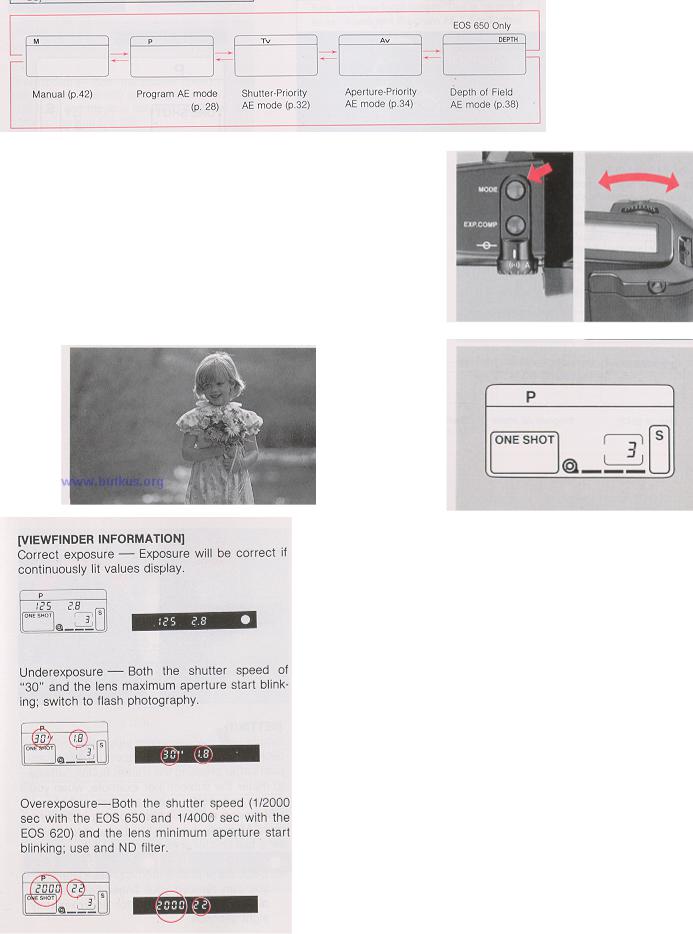
(1 ) Program AE [Purpose]
The camera automatically sets shutter speed/ aperture combinations according to subject brightness. This mode particularly suits first-time SLR users or those who prefer to concentrate on picture composition or candid snapshots.
[SETTING]
While pressing the shooting mode selector, turn the electronic input dial until "P" appears in the display panel.
When the automatically-set shutter speed is too slow to hand-hold, the camera will sound a long beeper tone to warn you. We recommend using a tripod or flash.
The camera selects the ideal program line according to the characteristics of the lens in use, i.e., the maximum or minimum aperture and lens focal length. This is referred to as "Intelligent Program AK." For further information on the program line, please see pp. 79 and 80.
This program AE mode has the same characteristics as the one selected when the main switch is set to the green " [ ] " mark (see p.14). However, the "ONE SHOT" AF and "S" film winding modes are automatically set so use the setting described on this page when you want to use the "SERVO" AF mode or "C" film winding mode.
(2) Program Shift Functions (EOS 620 Only)
